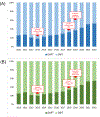Determinants and Temporal Trends of Dual Antiplatelet Therapy After Mild Noncardioembolic Stroke
- PMID: 37675611
- PMCID: PMC10530464
- DOI: 10.1161/STROKEAHA.123.043769
Determinants and Temporal Trends of Dual Antiplatelet Therapy After Mild Noncardioembolic Stroke
Abstract
Background: Short-term dual antiplatelet therapy (DAPT) reduces early stroke recurrence after mild noncardioembolic ischemic stroke (NCIS). We aim to evaluate temporal trends and determinants of DAPT prescription after mild NCIS in the Florida Stroke Registry, a statewide registry across Get With The Guidelines-Stroke participating hospitals.
Methods: In this cross-sectional analysis of a cohort study, we included patients with mild NCIS (National Institutes of Health Stroke Scale score ≤3) who were potentially eligible for DAPT across 168 Florida Stroke Registry participating hospitals between January 2010 and September 2022. Using antiplatelet prescription as the dependent variable (DAPT versus single antiplatelet therapy), we fit logistic regression models adjusted for patient-related factors, hospital-related factors, clinical presentation, vascular risk factors, and ischemic stroke subtype, to obtain adjusted odds ratios (aORs) with 95% CIs.
Results: From 283 264 Florida Stroke Registry ischemic stroke patients during the study period, 109 655 NCIS were considered eligible. Among these, 37 058 patients with National Institutes of Health Stroke Scale score >3 were excluded, resulting in a sample of 72 597 mild NCIS (mean age 68±14 years; female 47.3%). Overall, 24 693 (34.0%) patients with mild NCIS were discharged on DAPT and 47 904 (66.0%) on single antiplatelet therapy. DAPT prescription increased from 25.7% in 2010 to 52.8% in 2022 (β/year 2.5% [95% CI, 1.5%-3.4%]). Factors associated with DAPT prescription were premorbid antiplatelet therapy (aOR, 4.66 [95% CI, 2.20-9.88]), large-artery atherosclerosis (aOR, 1.68 [95% CI, 1.43-1.97]), diabetes (aOR, 1.29 [95% CI, 1.13-1.47]), and hyperlipidemia (aOR, 1.24 [95% CI, 1.10-1.39]), whereas female sex (aOR, 0.83 [95% CI, 0.75-0.93]), being non-Hispanic Black patients (compared with non-Hispanic White patients; aOR, 0.78 [95% CI, 0.68-0.90]), admission to a Thrombectomy-capable Stroke Center (compared with Comprehensive Stroke Center; aOR, 0.78 [95% CI, 0.66-0.92]), time-to-presentation 1 to 7 days from last seen well (compared with <24 h; aOR, 0.86 [95% CI, 0.76-0.96]), and small-vessel disease stroke (aOR, 0.81 [95% CI, 0.72-0.94]) were associated with not receiving DAPT at discharge.
Conclusions: Despite a temporal trend increase in DAPT prescription after mild NCIS, we found substantial underutilization of evidence-based DAPT associated with significant disparities in stroke care.
Keywords: aspirin; atherosclerosis; clopidogrel; hyperlipidemia; ischemic stroke.
Conflict of interest statement
Figures


Similar articles
-
Analysis of Prescriptions for Dual Antiplatelet Therapy After Acute Ischemic Stroke.JAMA Netw Open. 2022 Jul 1;5(7):e2224157. doi: 10.1001/jamanetworkopen.2022.24157. JAMA Netw Open. 2022. PMID: 35900761 Free PMC article.
-
Comparative Effectiveness of Dual Antiplatelet Therapy With Aspirin and Clopidogrel Versus Aspirin Monotherapy in Mild-to-Moderate Acute Ischemic Stroke According to the Risk of Recurrent Stroke: An Analysis of 15 000 Patients From a Nationwide, Multicenter Registry.Circ Cardiovasc Qual Outcomes. 2020 Nov;13(11):e006474. doi: 10.1161/CIRCOUTCOMES.119.006474. Epub 2020 Nov 17. Circ Cardiovasc Qual Outcomes. 2020. PMID: 33201737
-
Exploring Sex Differences in Outcomes of Dual Antiplatelet Therapy for Patients With Noncardioembolic Mild-to-Moderate Ischemic Stroke or High-Risk Transient Ischemic Attack: A Propensity-Matched Analysis of the READAPT Study Cohort.Stroke. 2025 Feb;56(2):305-317. doi: 10.1161/STROKEAHA.124.049210. Epub 2024 Dec 9. Stroke. 2025. PMID: 39648888
-
Dual antiplatelet therapy with clopidogrel and aspirin after ischemic stroke: A review of the evidence.Am J Health Syst Pharm. 2015 Oct 1;72(19):1623-9. doi: 10.2146/ajhp140804. Am J Health Syst Pharm. 2015. PMID: 26386103 Review.
-
Navigating Antiplatelet Treatment Options for Stroke: Evidence-Based and Pragmatic Strategies.Curr Neurol Neurosci Rep. 2022 Nov;22(11):789-802. doi: 10.1007/s11910-022-01237-z. Epub 2022 Oct 13. Curr Neurol Neurosci Rep. 2022. PMID: 36227497 Review.
Cited by
-
Cost-Effectiveness of Increased Use of Dual Antiplatelet Therapy After High-Risk Transient Ischemic Attack or Minor Stroke.J Am Heart Assoc. 2024 Apr 2;13(7):e032808. doi: 10.1161/JAHA.123.032808. Epub 2024 Mar 27. J Am Heart Assoc. 2024. PMID: 38533952 Free PMC article.
-
Uptake of Dual Antiplatelet Therapy After High-Risk Transient Ischemic Attack at a University Hospital.Neurohospitalist. 2024 Oct 9:19418744241289625. doi: 10.1177/19418744241289625. Online ahead of print. Neurohospitalist. 2024. PMID: 39544269 Free PMC article.
-
Beyond RCTs: Short-term dual antiplatelet therapy in secondary prevention of ischemic stroke and transient ischemic attack.Eur Stroke J. 2024 Dec;9(4):989-999. doi: 10.1177/23969873241255250. Epub 2024 Jun 13. Eur Stroke J. 2024. PMID: 38869034 Free PMC article.
References
-
- Wang Y, Wang Y, Zhao X, Liu L, Wang D, Wang C, Wang C, Li H, Meng X, Cui L, et al. Clopidogrel with aspirin in acute minor stroke or transient ischemic attack. N Engl J Med. 2013;369:11–19. - PubMed
-
- Pan Y, Elm JJ, Li H, Easton JD, Wang Y, Farrant M, Meng X, Kim AS, Zhao X, Meurer WJ, et al. Outcomes Associated With Clopidogrel-Aspirin Use in Minor Stroke or Transient Ischemic Attack: A Pooled Analysis of Clopidogrel in High-Risk Patients With Acute Non-Disabling Cerebrovascular Events (CHANCE) and Platelet-Oriented Inhibition in New TIA and Minor Ischemic Stroke (POINT) Trials. JAMA Neurol. 2019;76:1466–1473. - PMC - PubMed
-
- Brown DL, Levine DA, Albright K, Kapral MK, Leung LY, Reeves MJ, Sico J, Strong B, Whiteley WN. Benefits and Risks of Dual Versus Single Antiplatelet Therapy for Secondary Stroke Prevention: A Systematic Review for the 2021 Guideline for the Prevention of Stroke in Patients With Stroke and Transient Ischemic Attack. Stroke. 2021;52:e468–e479. - PubMed
Publication types
MeSH terms
Substances
Grants and funding
LinkOut - more resources
Full Text Sources
Medical

